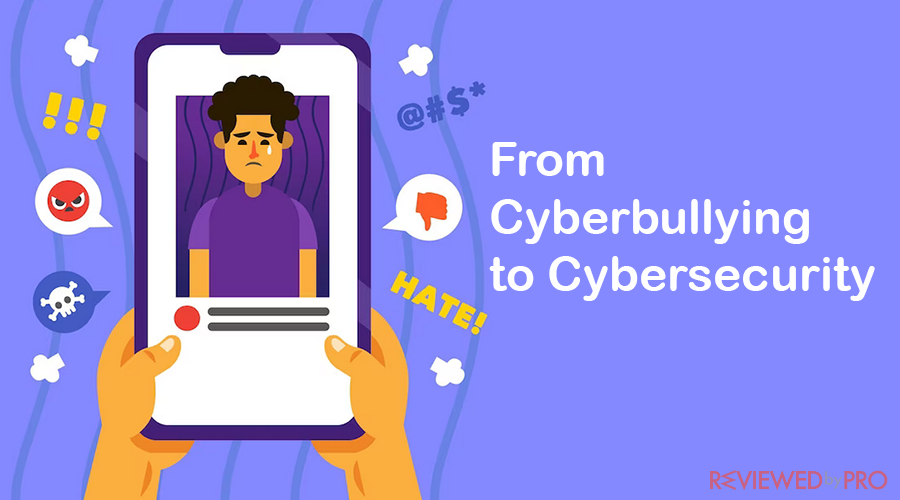
The rise of technology has resulted in new forms of harassment and risks that can have serious consequences for both individuals and organizations. In the digital age, online harassment, or cyberbullying, has become a growing concern, particularly among young people. Simultaneously, data breaches, in which personal information is stolen from businesses or individuals, are also becoming more common. While these may appear to be distinct issues, there is a strong connection between cyberbullying and cybersecurity. This article will investigate this connection and discuss how cyberbullying can lead to data breaches, as well as how data breaches can increase the risks of cyberbullying.
What is Cyberbullying?
Cyberbullying is a type of harassment that happens over digital means of contact. It can take many forms, like sending mean messages or threatening comments, posting provocative or upsetting messages, sharing private photos or videos without permission, or trying to be someone else to hurt their image or relationships. Cyberbullying harms the victim's mental health and well-being and could hurt their image, relationships, and job opportunities in the long run.
What is Cybersecurity?
Cybersecurity prevents unauthorized access, theft, and damage to computer systems, networks, and sensitive data. Cybersecurity threats can come in various shapes and sizes, including hacking, malware, phishing, ransomware, and data breaches. Because we use technology in our daily lives and more sensitive information is being stored and transmitted online, cybersecurity has become a crucial issue.
The Link Between Cyberbullying and Cybersecurity
Although it may not be immediately apparent, there are several connections between cyberbullying and data breaches. Here are a few instances:
- Sharing Sensitive Information. To launch a cyberattack, cyberbullies may use the victim's contact information, such as their phone number or email address. A cyberbully may, for instance, send phishing emails to a victim using their email address or a SIM swapping attack using the victim's phone number.
- Weak Passwords. Victims of cyberbullying may be more vulnerable to cyber attacks if they use weak or easily guessable passwords. Cyberbullies may also try to access their victim's social media or email accounts by guessing passwords.
- Social Engineering. Cyberbullies may use social engineering tactics, such as pretending to be someone else online, to trick their victims into revealing sensitive information. This can include passwords, credit card numbers, or other personal information.
- Revenge Attacks. Victims of cyberbullying may be tempted to retaliate by launching a cyber attack against the bully. This can lead to a vicious cycle of online harassment and cyber attacks, with both parties becoming increasingly vulnerable to cybersecurity risks.
Preventing Cyberbullying and Data Breaches
Preventing cyberbullying and data breaches requires a proactive approach involving individuals and organizations. Here are some ways to avoid cyberbullying and data breaches:
Educate and Raise Awareness
Education and awareness-raising campaigns can help individuals understand the risks of cyberbullying and data breaches and learn how to protect themselves from these threats.
Use Strong Passwords
Using unique, complex passwords for each online account can help prevent cyberbullying and data breaches.
Enable Two-Factor Authentication
Two-factor authentication adds an extra layer of security to online accounts by requiring a second verification form, such as a text message or app.
Use a VPN
Choose the best VPN for Chromebook or any other laptop, as it will encrypt your personal data, meaning that third parties won’t be able to intercept it.
Be Careful with Personal Information
Be cautious about sharing personal information online and avoid posting sensitive information such as your phone number or address.
Report Cyberbullying
If you experience cyberbullying, report it to the appropriate authorities or platform. Most social media platforms have reporting tools for cyberbullying and harassment.
Keep Software Up to Date
Keep your software and operating systems up to date with the latest security patches and updates to prevent data breaches.
Use Antivirus Software
Install antivirus software on your computer and mobile devices to protect against malware and other cyber threats.
Develop Strong Security Policies
Organizations should develop strong security policies to prevent data breaches, including regular security training for employees, using encryption to protect sensitive data, and limiting employee access to sensitive information.
The Role of Technology Companies in Addressing Cyberbullying and Data Breaches
Technology companies have a critical role in addressing cyberbullying and data breaches. They have developed policies and tools to prevent and address cyberbullying on their platforms, such as automated filters and the ability to report and block users who engage in harassing behavior. However, there is more technology companies can do to address cyberbullying and data breaches.
Develop Sophisticated Filters
Automated filters can effectively identify and remove cyberbullying content, but they are not foolproof. Technology companies can invest in developing more sophisticated filters that can better detect and remove cyberbullying content.
Increase Transparency Around Data Breaches
Organizations should be transparent about data breaches and communicate effectively with their customers about the steps they are taking to prevent and address them.
Develop Stronger Security Measures
Technology companies can develop stronger security measures to prevent data breaches, such as using encryption to protect sensitive data and implementing two-factor authentication.
Invest in Research
Technology companies can invest in research to better understand the link between cyberbullying and data breaches and develop practical solutions to address these issues.
Conclusion
In conclusion, cyberbullying and data breaches are two significant threats in the digital age that can have serious consequences for individuals and organizations alike. There is a clear link between cyberbullying and cybersecurity, with cyberbullying often leading to data breaches and vice versa. Preventing cyberbullying and data breaches requires a proactive approach involving individuals and organizations. Technology companies have a critical role in addressing these threats, and there is much they can do to prevent cyberbullying and data breaches and develop effective solutions to address these issues.




